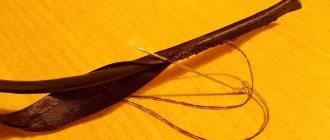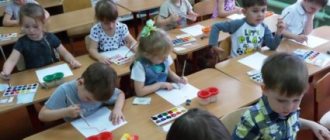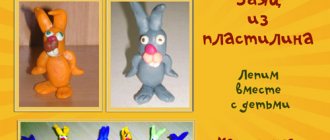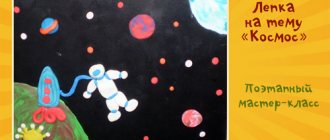Summary of a comprehensive lesson in the middle group: traffic rules and modeling “Truck”
Complex lesson: Traffic rules and modeling “Truck”
(in the second junior group - at the end of the school year, in the middle group) Objectives: Clarify children’s understanding of the street, roadway, sidewalk. To consolidate some rules for the movement of pedestrians on the street, the concepts of “crossing” and “pedestrian”. Strengthen children's understanding of the purpose of traffic lights for cars and people. Strengthen modeling techniques: rolling the dough between your palms; Practice using the flattening technique”; Strengthen the ability to connect parts, pressing them tightly to each other; Cause a positive emotional response to the overall result; Encourage the need to follow traffic rules. Demonstration material: model of the roadway, plasticine craft “Truck”, image of a traffic light. Handouts: plasticine, modeling boards, sticks (wooden toothpicks without sharp ends).
Progress of the lesson
- Guys, today we have an unusual activity.
We have a lesson with a surprise. Before I show you the surprise, you need to answer my questions. You are ready? - What is this? To help you, my friend, The path is dangerous, Lights are burning day and night, Green, yellow, red. — That's right, it's a traffic light. Who remembers the poem about traffic lights? - Well done boys! What do you think, what is a traffic light for? ( to pass the roadway so that pedestrians and cars move according to the rules
) - You were able to answer my questions, so I will show you the surprise I have prepared (the teacher opens a fabric-covered model of the roadway).
-What do you think it is? ( This is part of the road
).
- Look carefully and show me the way. Guys, the road is called “roadway” by another name. — Is it possible to walk on the road, why? —Where do pedestrians go? — What else interesting did you notice? ( traffic light, pedestrian crossing
) - Can I cross the road anywhere?
— Look carefully at the layout and tell me what’s missing here? ( cars
) - Guess the riddle:
For this horse, food is Gasoline, and oil, and water, He does not graze in the meadow, He rushes along the road. — That's right, this is a car
.
- Now you and I will build cars for our road ourselves. To do this, you need to all sit down at the tables. - First, you and I will do exercises for our hands: Physical exercise “We are drivers” (children must show movements) We are driving, we are driving a car (moving the steering wheel)
Press the pedal
(stretch your arms forward)
Turn on the gas, turn it off
(turn the lever towards you, from ourselves)
We look intently into the distance
(palm to forehead)
The wipers count the drops To the right, to the left - cleanliness!
(“windshield wipers”)
The wind ruffles your hair
(ruffle your hair with your fingers)
We are drivers anywhere!
(right thumb up)
- Look at my craft, what does it look like?
— What parts does a truck consist of? ( from wheels, body, cabin
) In order to make wheels, you need to roll out 4 identical balls.
There are 4 pieces of plasticine in front of you, take a piece of plasticine and roll out the ball. Look carefully, I have a ball. I will slightly “flatten” this ball and I will get a small cake. I have 4 of these parts. I take a wooden stick and thread a wheel (the resulting part) onto the end of this stick. On the other end of the stick is the second piece. I also thread the remaining two wheels onto the ends of the second stick. Afterwards we take a large block of plasticine. Place another small block of plasticine on top of a large block of plasticine. Press tightly against each other. Now we put it on 2 wooden sticks. Our truck is ready. Result of the lesson: Designing a layout of the roadway with your own cars (you can do vocabulary work with the word “Parking”)
We recommend watching:
Summary of GCD in the middle group of a preschool educational institution on traffic rules. Summary of a lesson on traffic rules in the middle group. Traffic rules Summary of a lesson on traffic rules in kindergarten in the middle group. Road signs
Similar articles:
Summary of a lesson on traffic rules in the middle group on the topic “Rules of conduct on the railway”
Summary of a lesson on traffic rules in the middle group. Crossroads
Summary of a lesson on traffic rules in the junior group of kindergarten according to the Federal State Educational Standard. Topic: Trolleybus
Lesson summary - excursions on traffic rules in the middle group of kindergarten
Conversation about traffic rules in the middle group
Progress of the lesson:
Playback :Guys, guess the riddle:
The red tongue is not used to dozing.
Once or twice he licked all the wood. (fire)
Playback : What words helped you solve the riddle? (Red, licked all the wood)
Playback : You and I know how fire arises and who fights it. Just like in a real battle, firefighters suffer heavy losses in the fight against fire and constantly live a tense life full of anxiety from the dangers. This is a highly qualified service with an alarm system, powerful fire engines , pumping units, and special heat-protective suits. These people need to bow deeply for their work. It is necessary to respect their profession and be grateful for the work of these people, for their willingness to risk their lives to save others from harm. Tell me, how do firefighters get to a fire ? ( Firemen ride in cars )
Playback : Great, but our firefighters’ cars have broken down and they can’t save people. What should they do now? (We need to make fire trucks )
Playback : Let's help them and make fire trucks . And cars using a technique already known to you and me - plasticineography . But first we will stretch our fingers so that we can get precise lines.
One two three four five. (They move the machine forward and backward over each finger, starting with the thumb.)
The race can begin. (Now the same thing, but starting with the ring finger.)
In a circle, in a circle, forward and backward, (Now - in a circle in one direction and the other.)
But my fingers are slowing down my car . (Roll the machine again over the fingers , which are slightly bent.)
Closed. (They clench their fist.)
The car is already in the garage.
And the headlights went out, they don’t shine anymore. (They look into the small crack in the fist.)
Playback : Well done! We will carry out our work in three stages. And for this we need a sheet of cardboard, a simple pencil and colored plasticine .
Stage 1. Using a simple pencil, we draw the silhouette of a fire truck .
Stage 2. Apply red plasticine
Stage 3. Done! Now we need to add elements so that our machine
She looked like a firefighter . Add a ladder, a sleeve and number 01.
The children do the work.
An exhibition of fire engines . Children look at them, listen to the opinions of their comrades without interrupting them, and share their impressions.
Summary of direct educational activities in artistic creativity (drawing) on the topic “Fire Engine” Summary of direct educational activities in artistic creativity (drawing) on the topic “Fire Engine” Purpose: To consolidate.
Abstract of OOD on design in the preparatory group “Time Machine”. Program content: consolidate children's knowledge about time, professions, transport, continue to develop the skill of independently composing. Sculpting lesson notes. Plasticineography “Summer Forest” Tatyana Tuktamysheva Lesson summary on lenka (plasticineography) “Summer Forest” Goals and objectives: * development of fine motor skills * development of imagination. Master class “Do-it-yourself fire truck” All children really like to play with cars, and even girls! Children are especially attracted to construction equipment and special equipment. transport. And also kids. GCD for drawing in the preparatory group “A fire truck is rushing to a fire” “A fire truck is rushing to a fire” Program content: learn to convey proportions between objects and partial occlusion in a plot drawing. "Sunflower". Summary of a lesson on modeling using the non-traditional technique “plasticineography” in the middle group b] Goals and objectives. Teach children to create an image of a sunflower based on an unfinished composition (silhouette of a sunflower). Keep learning. Modeling lesson in the senior group “Here it is, the fragrant bread” (plasticineography) The children chose the theme for modeling on their own. Among all baked goods, bread turned out to be the most important, the most delicious, the most necessary.
Summary of GCD for modeling using waste material in the middle group "Car"
Publications on the topic:
"Maple Leaf". Applique from paper and fabric using waste material Applique is one of the types of visual arts based on cutting out, overlaying various shapes and fixing them on another.
Summary of a lesson on sculpting using natural materials in the junior group “Walnut Mouse” Summary of a lesson on sculpting using natural materials in the junior group on the topic “Walnut Mouse”
Purpose: To fail.
Photo report on GCD for sculpting using natural material “Spiders on a cobweb” Photo report on GCD for sculpting using natural material “Spiders on a cobweb”. Goal: to develop the ability to sculpt a spider, conveying its characteristics.
Summary of GCD for sculpting using natural material “Chamomile” (second junior group) Summary of GCD for non-traditional modeling techniques Age: Second junior group Topic: “Chamomile” with pumpkin seeds Program objectives: Educational:.
Summary of a lesson on designing in the middle group, from waste material (candy wrappers) “The Cheerful Clown” Purpose: - to introduce children to circus performers, to the profession of a clown - to teach children to work with waste material (candy wrappers), - to teach.
"Cockerel." Master class made from paper using waste material from candy wrappers. A cheerful and magical New Year holiday is coming. Each of us has a lot of sweets at home, and therefore candy wrappers, I suggest you make them.
Master class “Children making crafts “Birdhouse on a tree” using waste material” MASTER CLASS CHILDREN MAKING CRAFTS “BOOKBOOK ON TREE” senior preschool age CRAFT “BOOKBOOK ON TREE” USING.
GCD plan for modeling “Mushrooms grow in our forest.” Collective composition using natural materials Goal: to consolidate ideas about mushrooms that grow in our forest, to show techniques for conveying their images in sculpting. Objectives: exercise.
Lesson in the middle group on modeling using natural material “Aquarium” (team work) Topic: “Our aquarium”. Goals: To intensify the use of various sculpting techniques to create beautiful aquatic plants and decorative fish; continue.
A lesson in modeling using natural materials in the middle group. Collective work “Aquarium” Class in a secondary group on modeling using natural material “Aquarium” (team work) Tatyana Zvyagina Class in a secondary group.
Lesson in the preparatory group on sculpting “Fire Truck” (plasticineography)
Marina Smirnova (Solovieva)
Lesson in the preparatory group on sculpting “Fire Truck” (plasticineography)
Lesson in the preparatory group on sculpting “ Fire Engine ” ( plasticineography )
MBDOU "D/s No. 2 combined type"
preparatory group No. 2
Solovyova Marina Alekseevna
Educational: Teach children to draw “ Fire Truck ”
, achieve an accurate representation of the form, its structure and parts.
Developmental: Continue to develop an interest in working with plasticine using the familiar technique - plasticineography , develop fine motor skills.
Educational: to cultivate accuracy when doing work, to activate children’s imagination, to instill in children respect for a profession such as a firefighter , a respectful attitude towards their hard work, and an awareness of the dangers of this profession.
Preliminary work: Looking at illustrations with different types of transport, guessing riddles, reading poems on the topic, finger gymnastics “ cars ”
Materials and equipment:
Demonstration: photo of a fire truck .
Handout: Cardboard for each child, plasticine modeling board .
Looking at an illustration on the topic “ Fire Safety ”
; reading fiction.





